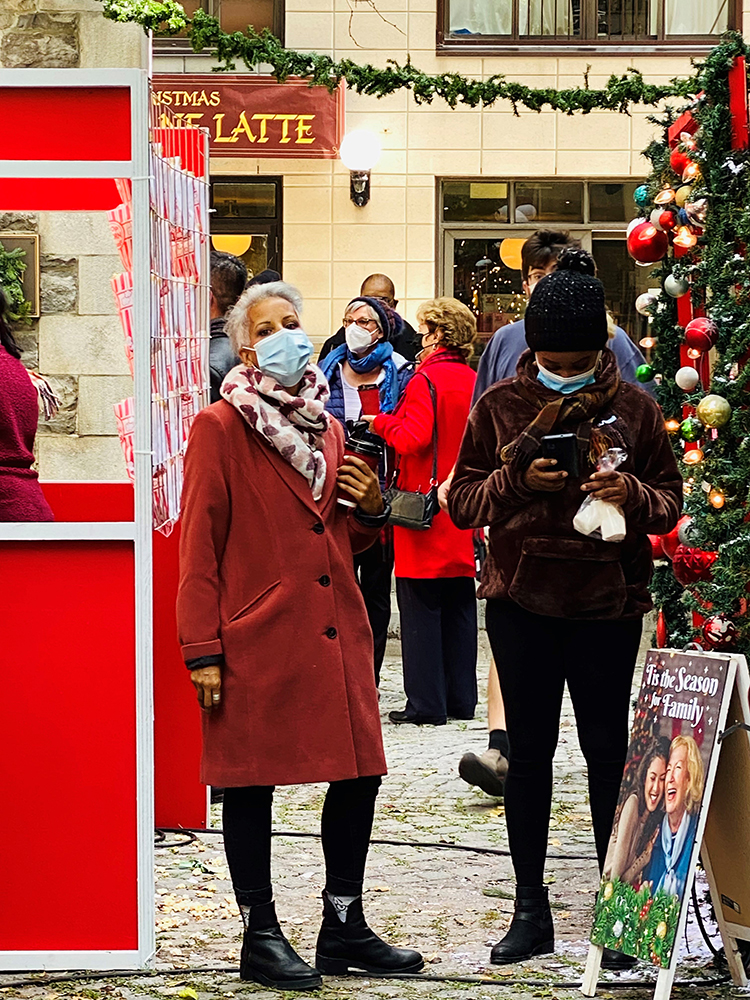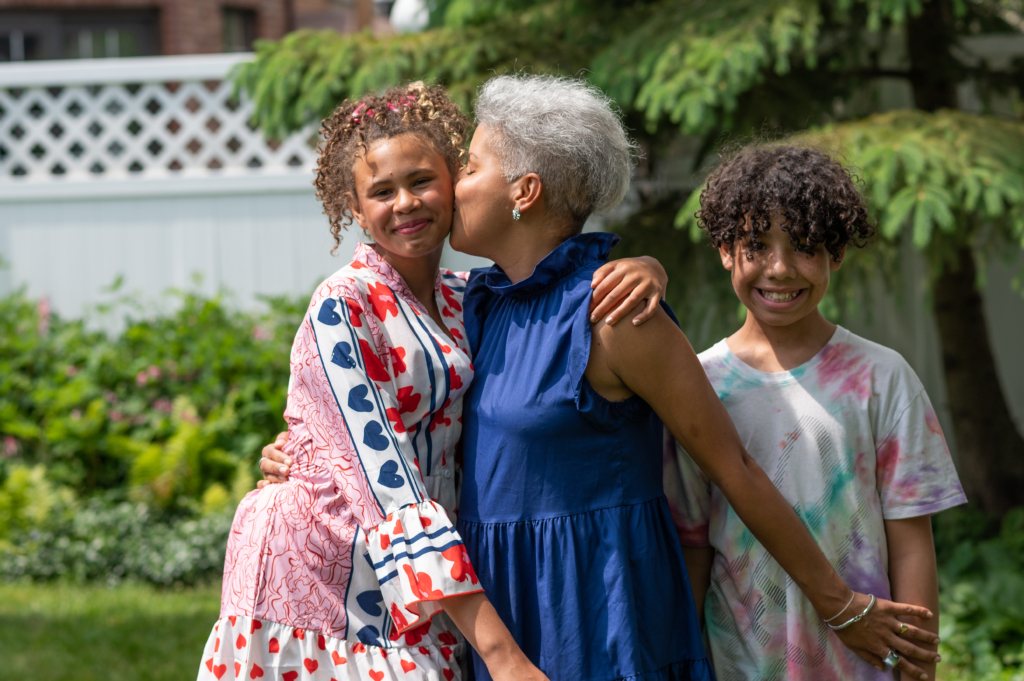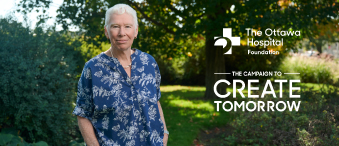Update: October 2023
Over the past few months, we’ve had the distinct privilege of working closely with Alison Hughes to share her story. Only 37 years old when she was diagnosed with breast cancer, she wanted to raise awareness, especially among other young woman like her.
We are heartbroken to learn that Alison passed away on Wednesday, October 11, 2023. We offer our deepest condolences to all those who knew and loved her, and we remain profoundly inspired by her.
Originally published: September 2023
This is Alison’s story told in her own words.
I wanted to share my story now, because I want more young women to have a story they can relate to. Sadly, breast cancer doesn’t just affect women over 50. By sharing my story, I hope I can help younger women better understand what this journey is all about, because I didn’t really have that when I was first diagnosed ten years ago.
At that time in my life, I owned a consignment store specializing in women’s fashion. I love fashion, so it was a great fit for me. I also had two young children — life was busy.
But then I got the shock of a lifetime. It started when I found a lump on my right breast, and I remember telling my husband at the time that it hurt. He told me not to freak out, but I just had this feeling something was wrong, so I called my doctor.
My way of coping with a breast cancer diagnosis
“I can’t do this…I have no room in my life for this right now – this can’t be happening!’
— Alison Hughes
I drove back to my store and remember thinking ‘I can’t do this. I have a two-year-old and a three-and-a-half-year-old. I have no room in my life for this right now – this can’t be happening!’
But it was happening, and within two weeks, I had a PICC line inserted, and chemotherapy soon followed. The news of my diagnosis was particularly difficult for my parents because my dad’s mom died from breast cancer in her mid-thirties. So, I said ‘We have one day to cry and then after that, for the outside world, there’s nothing happening.’ We hid my diagnosis from almost everyone — that was my coping mechanism. Everyone has their own way of coping – this was mine.
Soon, I met Dr. Mark Clemons. I refer to him as my first oncologist and now my forever oncologist. We clicked. He was well informed, supportive, and had time for all the questions we had for him. He gave me confidence to know that the choices he was making were not from just a singular perspective, he was looking at my total healthcare options.




The specialized team ready to handle my care
But he wasn’t alone. There was an entire team at The Ottawa Hospital ready to help me have more time to watch my children grow.
From September to December 2013, I underwent chemotherapy, but by the fifth and sixth treatment, I was hit hard. My beautiful hair fell out, my skin turned gray, and I was in bed all the time. Then in February of 2014, just as I gained back most of my strength, I had a mastectomy. During that operation, a bunch of lymph nodes from under my right arm were removed and sent for testing. We’d later learn that more than half of them were cancerous. That’s when radiation treatment started.
The care was amazing, and so were the resources made available to me afterwards, because that is a difficult operation to undergo. I had access to psychosocial oncology, as well as a dietitian.
By that summer, I started feeling better, and that’s when I started telling people what I had gone through. Sometimes they’d turn white as a sheet when they heard the news — I really believe it’s because there’s not a lot of women my age that relate to this kind of a diagnosis.
Then after five years, I was doing well and released from the cancer program. I had successfully recovered from breast cancer — or so I thought.
Devastation when cancer metastasized
In 2021, in the middle of the pandemic, I experienced a ton of pain in my back and my hips. I started physio and got relief for a few days but then it came back. One day at work, I tripped on a mat, fell, and couldn’t get back up at first. I kept getting this insane spasm. Later that night my parents found me on the floor, unable get up. They helped me into bed, and I stayed there for four days.
Then one day my daughter noticed my leg looked like I’d been burned by a big rod. I looked at my kids and I said, ‘I think I should go to the hospital.’ Little did I know my world would be turned upside down, again.
“I went from seeing a physiotherapist because of my back pain to stage 4 cancer with possibly only months to live. It was almost too late.”
– Alison Hughes
My body was riddled with cancer
The next thing I knew, I dove back into treatment. I had a radiation team, an oncology team, and a palliative team. I had a home nurse as well as psychological support. The resources are unbelievable.
I moved back in with my parents, along with my kids who were then 10 and 12, because I was at a point where I couldn’t climb a set of stairs, and I couldn’t really function on my own. In addition to the blood clots, I had multiple broken bones from the cancer and crooked shoulders from all the broken bones in my back. I was either in a wheelchair or walked with a cane, and my stomach was really bloated because of the disease. There was just so much going on — my body was in emergency mode.
While my extensive team at the hospital mobilized, my parents took care of me and the kids, and our incredible network of neighbours rallied alongside us. That meant I could be in treatment, and the kids could still have some normalcy — they could go outside and play.

Finally, there was some good news
From June 2021 through until February 2022, I had radiation led by Dr. Laval Grimard to help with the cancer in my bones, followed by chemotherapy. After a clinical trial was not successful, Dr. Clemons tried me on a new chemo option that finally brought some hope. In June 2022, I started to feel better.
By that summer, my spine started straightening, I could move better. And my health continuously improved. All my bones healed, the tumors shrunk, and I could walk unassisted most of the time. I was back working part time as a background actor in movies — maybe you’ve seen me in a Hallmark movie — I also do some modelling.
By the spring of 2023, I had a clear scan, and I went overseas to spend some time in Oxford and London — it was spectacular. But when I returned home in early June, I could feel my body grinding to a halt. I could barely walk. The next thing I knew, I was in a wheelchair — I couldn’t walk. It happened fast.

Little did we know what would come next
Once again, I was thrust into emergency mode to determine what was happening. I had x-rays and scans, and I don’t think any one of us expected to see what we saw on those scans. I was pretty sure this was it for me.
There were new lesions on my lower spin and this time they also found a tumour on my brain. Immediately, my care team acted. My new plan included five radiation treatments on my back and one on my brain. Then I started a new type of chemo treatment in August. This chemo is at the forefront of treatment options, and I can’t thank Dr. Clemons enough. I call it the Cadillac of treatment — I feel really lucky. And the way I see it is, if I can be an early user of this drug and they can learn from me, that’s a good thing.
“My philosophy is, if you can test me or use my blood or do something with me that's going to make things better for someone else, sign me up.”
– Alison Hughes

In fact, I often find myself thinking, ‘Who gets this many chances?’ And that’s why I’m sharing my story. I’m fortunate for the care, the support, and the learning because life doesn’t always gets perfectly tied with a bow — not everyone gets a bow.
I don’t know what the future holds.





































